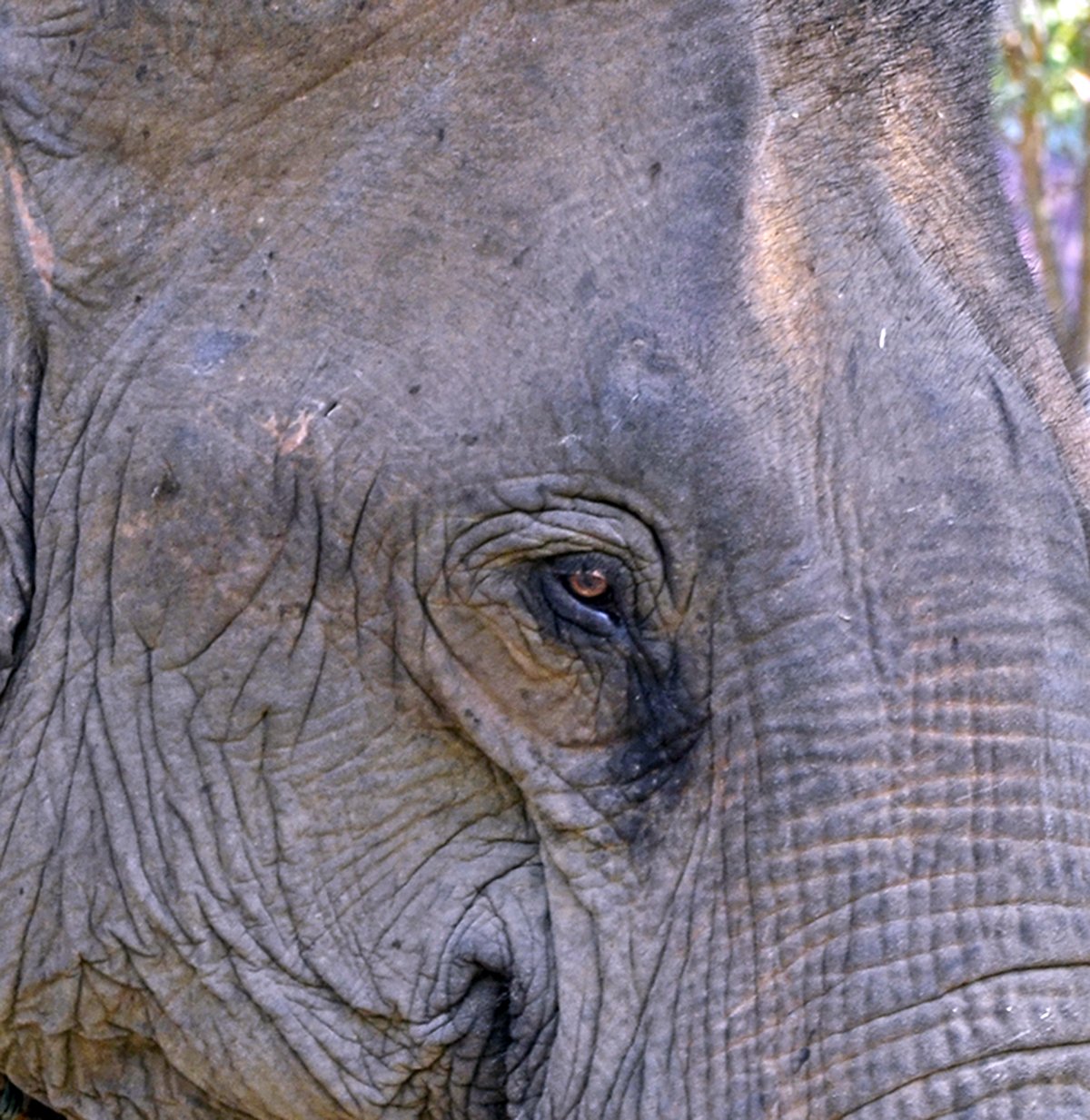
Sayaboury Elephant Conservation Center
Weathered wood cabins with solar panels and cedar-shake roofs frame the man-made Nam Tien Lake that shimmers like dancing diamonds in the tropical sun of Laos.
I follow the scent of frangipani blooming along the walkway and bordering the lush green jungle beyond, to the dining hall where a donation box invites me to drop an always-welcome coin into the coffers of Laos’ first Elephant Conservation Center. In the distance I hear the high-pitched trumpeting of an elephant and seconds later, from the opposite direction, a response.
Sebastien Duffillot and Gilles Maurer, founders of the Center, worked in the Laos logging industry for six years during the 1990s. Before returning to their homes in France, they took a life-changing motorcycle vacation, biking on the Mekong River in Sayaboury province, where the last of the mahouts and 800 domestic elephants were used for logging. After observing the brutal working conditions of the animals, Sebastien and Gilles realized the tragedy behind the rapidly declining population in a land once known as the “land of a million elephants.”
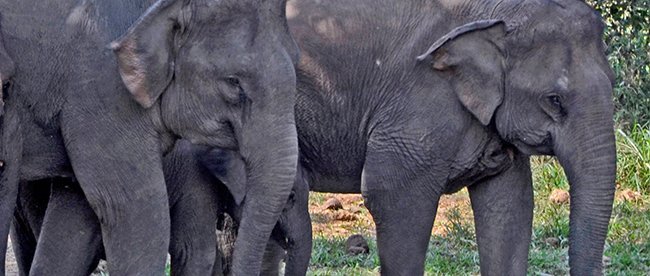
Rather than returning to France, the men spent months brooding, researching, discussing and arguing about what could be done for the elephants. They concluded that, as a first step, the Laotian public had to be informed of the disappearing animals and the impact that disappearance was having on their culture.
After fund raising, government lobbying and planning, the first ElefantAsia caravan hit the road in 2002 covering a total of 1300 kilometers between Champassak in the south and Luang Prabang in the north, showcasing four elephants that slowly paraded through the villages demonstrating their skills and their contribution to Laotian culture.
Encouraged by the success of the caravan, Sebastien and Gilles felt they could and would do more. With cooperation from the mahouts they again lobbied government and begged sponsoring organizations such as the American Fish and Wildlife for money to implement a long-term conservation program for domesticated elephants.
Finally, in 2005 they were able to hold the first Elephant Festival with parades that included about sixty elephants. They held workshops and training demonstrations, and gave rides to children. There were talks and pamphlets touting the regal role elephants had once played and they organized the “elephant of the year” contest, which chose the best team of owner and animal in terms of welfare for both.
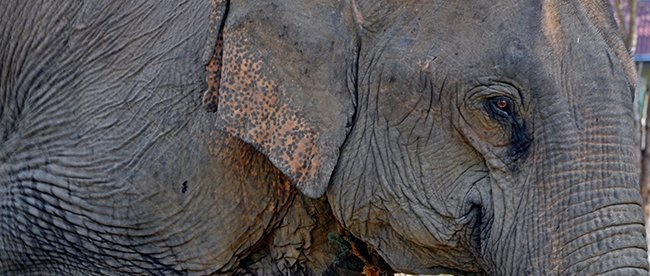
The events resulted in many Laotian people remembering that historically elephants symbolized fortuity, silent power, kindness and majesty. The necessity of preserving the species and in turn, the Laotian culture itself, became clear.
But success has its difficulties too. Because of the enormous amount of work that needed to be done, Sebastien and Gilles split their organization, with each complimenting the other. Gilles took responsibility for ElefantAsia. He worked with government and mahouts to shorten working hours, to abolish corporal punishment and to offer immediate medical care when injury or sickness arose. Gilles and his organization built a hospital and employed a full-time veterinarian.
Sebastien took over conservation and education. His first objective was finding a home for the animals. He begged non-governmental organizations for financial help and negotiated with government for land that could be used to house and care for orphaned, injured or retired elephants. He employed full time veterinarians and biologists to implement the latest theories of care
In 2011, the land was granted: 106 hectares of jungle surrounding Nam Tien Lake in Sayaboury Province. Sebastien hired local people to build the huts, dining hall and kitchen. He adopted five animals that made the first domestic herd in the country. He opened a school that instructed mahouts in the reward system of management rather than the fear and punishment method.

Gilles and Sebastian also developed a registration system that includes the placing of microchips in the ears of elephants. The chip identifies the animal, its age, sex, owner and any pertinent medical information. The corresponding records are kept at the Department of Livestock in the Ministry of Agriculture and Forests.
When I visited there were six adults and one youngster who were permanent residents. I was far more interested in the management and history of the project than I was in the animals, but I tagged along watching the daily routine.
Under a thatched hut that gave the elephants and me protection from the sun, I watched a mahout with stick in hand make a sound to his elephant while gently tapping the back of her knee. The elephant and the mahout sauntered toward the lake with visitors, staff and biologists in tow.
Tourists riding elephants is discouraged at the Center whereas observation and “soft interaction” is encouraged. Soft interaction includes, at specific times, feeding the animals tufts of their favourite grasses and leaves but mostly learning from observation.
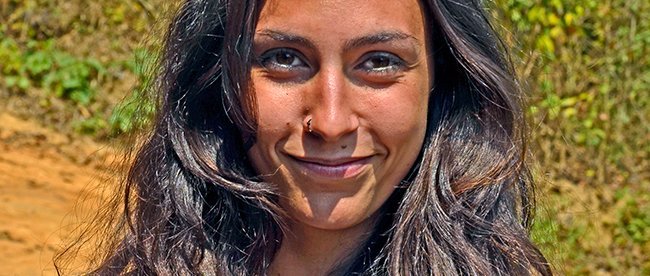
As we walked, Anabel, the resident biologist, discussed the theory of mahout training, telling me how much she loved animals in general and elephants in particular, and giving me a rundown on the day’s events.
“We pay mahouts to train here,” she explained. “If they didn’t get paid the hardship would be too difficult for them and their families so many would bypass the program.”
At the lake I watched all seven resident elephants enter the water to romp and splash and blow water onto their backs. Mae Dok, the oldest of the “aunties” as the females of this herd were called, stayed off to the side. She entered the water, but after just a few splashes she exited the lake and stood alone, head pointed toward the jungle.
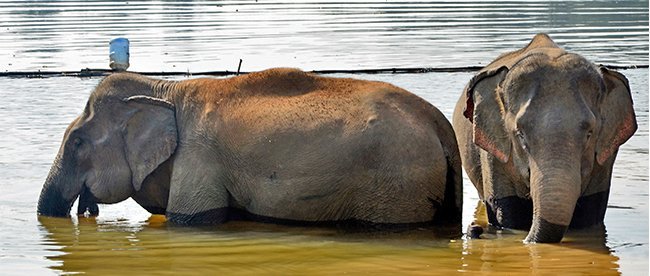
“She’s retired,” Anabel said. “She worked long and difficult hours in logging and now behaves like an old lady amongst a group of young girls.”
My heart took a slight flip. I kept my eye on her and wished I could give her a peanut like Dumbo got in the movies.
My attention was drawn to the baby of the herd, a four-year-old male called Suriva who played and splashed like all youngsters. Once on shore, he went directly to his mother and nursed. How cute, I thought and followed Anabel up the hill to the socialization area. We climbed onto a tower from where we could watch “normal” elephant behaviour as would be encountered in the wild.
Mae Dok, the first to arrive went to the farthest reaches of the coral and pointed her head toward the jungle. This time I just wanted her to wrap my arms around her trunk for a few minutes.
A mahout was on the back of Suriva’s mother, Mae Ven, and was directing her away from the socialization pen toward the jungle. She stopped, turned and trumpeted. Suriva responded as most children would and moved towards her but a second mahout stood in the way. Suriva returned to the pen and trumpeted back.
I heard crashing and banging, the splintering of wood and more trumpeting from both mother and child.
“Suriva must be weaned,” Anabel explained, grinning at the destruction being wreaked on the jungle by the upset mother.
Being a typical child Suriva soon forgot about the mom’s teat and walked over to his aunties for comfort, which they were all too eager to supply. The babe stood between the two females who wrapped their trunks around his, rubbed his head and back, moved even closer and did more trunk hugging. Then auntie took a stick and scratched Suriva’s leg. He responded by lifting his leg for more scratches and at the same time, did more trunk hugging.

Mae Dok in the meantime, kept to herself, her head outside the confines of the coral, totally uninterested in comforting Suriva. The joy of the child, the agony of the mother and the heartbreak of the old lady were more than I could take. I now understood how Anabel felt. Elephants were special.
The philosophy of the Center is not about attracting tourists to raise money, but rather about developing a permanent herd of ten to twenty animals that would stay together like they do in the wild. In part, the Center raises funds by taking in paying guests, up to 30 at a time but no more than a dozen new ones a day. This way each person has time for questions and the workers such as Anabel have the time to respond. Or even better, they can show the guests how things work. Children are welcome — they quickly fall in love with the elephants and draw their parents in.
Because of organizations such as these two in Sayaboury people the world over might put enough pressure on the governments to preserve this species.
First published in the Prince George Citizen 2015
